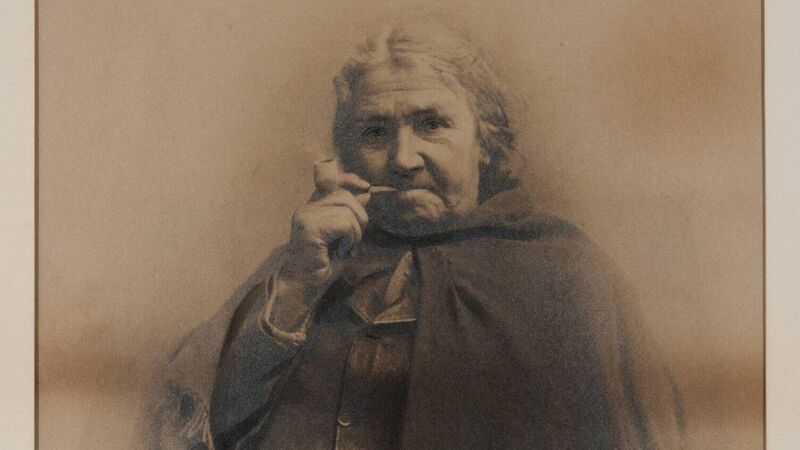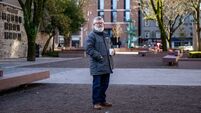Clodagh Finn: Big Rachel, the 6ft 4in labourer, is a giant of our hidden history

Rachel Hamilton, the formidable 6ft 4in pipe-smoking shipyard worker and Irishwoman who was hired as a special constable to quell the riots that broke out during the centenary celebrations of Daniel O’Connell’s birth, almost 150 years ago this week. Picture: © CSG CIC Glasgow Museums Collection
She is not very well known here, in the country of her birth, but Rachel Hamilton, the towering navvy, labourer and peacekeeper, is celebrated with affection in her adopted Glasgow.
If you take a walking tour of the city’s West End, you’ll hear a little more about this gutsy lady, who worked as a forewoman navvy in the Jordanhill Brickworks, where she had a reputation as a keeper of the peace and enforcer of order in the workplace.
It made sense, then, that she would be called upon when the Partick Riots erupted in Glasgow on August 6, 1875. Her imposing presence had something to do with it too. Several reports remark on her height and her weight: “She weighed about 16 stones and 10lbs,” said one.
During the first week of August, almost 150 years ago, she was sworn in as a special constable to “knock a few heads together… when Irish Home Rulers and Orangemen clashed on Dumbarton Road for three days”, as the put it.
The riot itself was blamed on an Orange lodge member who, according to the of the time, tore down and trampled on banners which were made to commemorate the centenary of the birth, on August 6, 1775, of Daniel O’Connell, the lawyer, orator and giant of Irish politics who fought for Catholic Emancipation.
, however, was quick to blame “rampant Irish patriotism” for putting the commercial metropolis of Scotland under “a sort of reign of terror for some days”. The paper did, however, concede that the "patriots" hadn’t started the trouble.
In any case, it can’t have been easy to stop the violence. “The rioters,” reports said, “freely used all sorts of weapons, including pokers, knives, and in one case a sword bayonet… and stones were thrown about quite regardless of consequences.”
After three days, an uneasy peace settled and, thanks to her role as peacekeeper, Rachel Hamilton (1829-1899) was guaranteed a place in the historical record. True, it may have come anyway as she was one of few women to work, by turns, as a shipbuilder’s labourer, a brickwork navvy and a farm labourer.
Her photograph survives too, an evocative portrait opening an unusual window into the life of one of the many Irish immigrants living in Scotland at the time. In it, she is described as “Mrs Rachel Hamilton or Johnston, (widow of William Johnston), a Partick worthy from the North of Ireland”.
It’s not clear when she arrived in Glasgow but her life there, or at least what is known of it, is recalled in a women’s heritage walk in Glasgow which follows in the footsteps of women with a connection to the West End. Indeed, Glasgow Women’s Library made history itself by creating the guided walking tour in 2007 – the first to focus on the pioneering women of the city.
As Naomi Brown, the library’s digital and marketing officer, explains: “Our walking tours aim to highlight the stories of Glasgow’s inspiring women who have, in the main, been overlooked by the history books.”
Next month, Glasgow Women’s Library marks its own 30-year history and its growth from a grassroots, volunteer-led group, founded in 1991, to an award-winning museum.
It is the only accredited museum in the UK dedicated to women’s history, lives and achievements. It has a lending library, runs public events and holds what it describes as “a treasure trove of historical and contemporary artefacts and archive materials that celebrate the lives, histories and achievements of women”.
More than that, Naomi Brown says, the organisation has been talking to groups of women in Pakistan, South Africa, the United States and Iran, and more, about setting up sister organisations across the globe. Perhaps we could talk about setting up something similar here too?

There has been talk of establishing a dedicated women’s museum to highlight and celebrate the many, many hidden female histories in Ireland.
The experience and contributions of women should, of course, be part of all museums and libraries but we have a lot of catching up – or levelling-up, as the current phrase goes – to do first.

Everywhere you look there are examples of how poorly women are represented. At Leinster House, the appointment of a new working group to look at the gender balance in the artwork displayed along the corridors of power illustrates that point all too clearly.
The existing artworks, for the most part, represent men in all their powerful glory with the exception of Countess Markievicz and a Noel Murphy portrait that features all women members of the Oireachtas in a single painting. There are 53 of them, about a quarter of the number of representatives in both houses.
Change, though, is coming. A new exhibition in Tipperary, ‘100 years of Women in Politics and Public Life’ curated by Dr Sinéad McCoole, shines a light on the women who shaped modern Ireland.
The press release expresses the wish that the exhibition will also “acknowledge and raise awareness of [women’s] substantial contribution to Irish history in politics and public service”.
It certainly has the potential to do so, because fleshing out a more balanced and representative picture of the past has an impact on the present – and the future. We need to be able to see what women could do, rather than what they could not.
In a similar vein, the marbled men of the Long Room of the Old Library in Trinity College Dublin are to welcome some high-achieving women.
Last month, the college named the artists who will create four sculptures of women to join the 40 marble busts of men already in situ. They will be joined by sculpture bust portraits of scientist Rosalind Franklin by Vera Klute; folklorist, dramatist and theatre-founder Augusta Gregory by Guy Reid; mathematician Ada Lovelace by Maudie Brady and the pioneering women’s rights advocate Mary Wollstonecraft by Rowan Gillespie.
Trinity said it recognised that its public spaces must better represent diversity, and, as a first step, it was introducing the sculptures of women.

The real change and the most welcome one, however, was the one that came into effect this week when Professor Linda Doyle became the first woman provost of Trinity College Dublin in its 429 years. Four new statues of women are welcome too, although it’s worth recalling that more than 500 women were nominated for inclusion in the Long Room.
Maybe in the coming years, some enterprising tour guide will develop a Big Rachel-style walking tour and talk at least some of them back into the public consciousness.
As the Glasgow Women’s Library says: “Women are part of everyone’s history and there are volumes of information still to be uncovered.”












